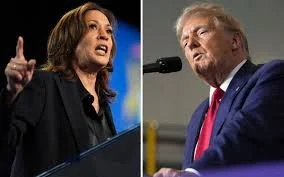What America Could Look Like: Kamala Harris vs. Donald Trump in 2024"
As the nation stands on the edge of another historic election, voters are torn between two very different visions for the future. What will America look like if Kamala Harris takes the Oval Office? And what changes might we see if Donald Trump reclaims the presidency? Here’s a peek into each candidate’s plans for the economy, healthcare, civil rights, foreign policy, and more—breaking down what’s really at stake.
Kamala Harris: A Focus on Equality, Healthcare, and Economic Support
Kamala Harris envisions a government that works for everyone, especially the middle class and working families. If elected, Harris has promised to roll out tax reforms aimed at alleviating financial pressures on American households. With a particular focus on the middle class, Harris has proposed expanding tax credits like the Child Tax Credit and the Earned Income Tax Credit, which were lifelines for many during the pandemic.
Healthcare under Harris would look much like an expanded version of the Affordable Care Act, with added protections and cost-saving measures on prescription drugs. This might mean lower costs for families, especially those burdened by chronic illnesses that demand constant medication. Harris is also vocal about protecting Medicare and Social Security, taking a stand to ensure these programs remain solvent for generations to come.
She’s spoken passionately about addressing affordable housing, planning to boost federal support for new construction and affordable rental options. She’s even proposed a fund to help first-time and first-generation homebuyers—a potential game-changer in high-cost cities where homeownership feels out of reach for most.
Trump's Vision: A Push for Nationalism, Business Incentives, and Immigration Overhaul
If Donald Trump makes his comeback, expect a very different path forward. Trump’s America would likely see tax cuts taken to new extremes, with promises to reduce corporate tax rates to incentivize U.S.-based manufacturing. These moves, he argues, would spark job creation and help America reclaim its manufacturing might. Trump has also floated the idea of universal tariffs, which he claims would protect American industries from international competition. However, some economists caution that such tariffs could mean higher prices for consumers, as imported goods become more expensive.
One of the most striking differences between Trump and Harris lies in their approach to immigration. Trump has vowed to crack down on immigration, with promises of large-scale deportation efforts and a return to strict border policies. He’s hinted at reviving the “Muslim Ban,” a controversial restriction that limits entry from certain Muslim-majority countries, and has spoken about ending birthright citizenship—a shift that would have a profound impact on millions.
On the foreign stage, Trump has hinted at a bolder, more isolated stance, particularly regarding NATO and other alliances. He's been vocal about potentially revisiting U.S. commitments to NATO, which could reshape the nation’s relationship with allies. His approach to trade would likely be more aggressive than in his first term, especially concerning China, as he sees tariffs as a means to bring jobs back to American shores.
Social Issues and Civil Rights: Where They Stand
Harris stands firm on civil rights, often championing causes like police reform and reproductive rights. She’s made it clear that, under her administration, abortion rights would be federally protected—a stark contrast to Trump’s platform, which includes supporting restrictions on abortion access.
Trump, on the other hand, appeals to voters with conservative values. He is a staunch opponent of expanding abortion access, and has suggested he would appoint conservative justices who align with his views, impacting how the Supreme Court might rule on key civil rights issues.
The Bottom Line
Choosing between Harris and Trump means choosing two vastly different futures. Kamala Harris offers a vision centered on equality, social safety nets, and reform-driven approaches to pressing social issues. Meanwhile, Trump’s platform emphasizes nationalism, deregulation, and stringent immigration measures, with promises to reassert American strength on the global stage.
For voters, this decision comes down to the kind of country they want to see in the years ahead: one focused on expanding social programs and civil rights, or one pushing for aggressive economic reform, tight immigration policies, and a robust, America-first stance. The stakes are high, and the choice will shape America’s direction for generations to come.


